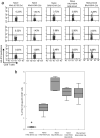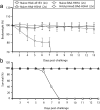Bovine adenoviral vector-based H5N1 influenza vaccine overcomes exceptionally high levels of pre-existing immunity against human adenovirus
- PMID: 18301400
- PMCID: PMC2700267
- DOI: 10.1038/mt.2008.12
Bovine adenoviral vector-based H5N1 influenza vaccine overcomes exceptionally high levels of pre-existing immunity against human adenovirus
Abstract
Because of the high prevalence of adenovirus (Ad) infections in humans, it is believed that pre-existing Ad-neutralizing antibodies (vector immunity) may negatively impact the immune response to vaccine antigens when delivered by human Ad (HAd) vectors. In order to evaluate whether bovine Ad subtype 3 (BAd3), a non-HAd vector, can effectively elude high levels of pre-existing vector immunity, naïve and HAd serotype 5 (HAd)-primed mice were immunized with BAd-H5HA [BAd3 vector expressing the hemagglutinin (HA) gene from H5N1 influenza virus]. Even in the presence of very high levels of HAd-specific neutralizing antibody, no significant reductions in HA-specific humoral and cell-mediated immune (CMI) responses were observed in HAd-primed mice immunized with BAd-H5HA. In naïve mice immunized with HAd-H5HA (HAd5 vector expressing H5N1 HA) and boosted with BAd-H5HA, the humoral responses elicited were significantly higher (P < 0.01) than with either HAd-H5HA or BAd-H5HA alone, while the CMI responses were comparable in the groups. This finding underlines the importance of a heterologous prime-boost approach for achieving an enhanced immune response. The immunization of naïve or HAd-primed mice with BAd-H5HA bestowed full protection from morbidity and mortality following a potentially lethal challenge with A/Hong Kong/483/97. These results demonstrate the importance of BAd vectors as an alternate or supplement to HAd vectors for influenza pandemic preparedness.
Figures




Comment in
-
Bovine adenovirus vectored vaccine for avian influenza.Mol Ther. 2008 May;16(5):807-8. doi: 10.1038/mt.2008.47. Mol Ther. 2008. PMID: 18432270 No abstract available.
Similar articles
-
A Bovine Adenoviral Vector-Based H5N1 Influenza -Vaccine Provides Enhanced Immunogenicity and Protection at a Significantly Low Dose.Mol Ther Methods Clin Dev. 2018 Jul 17;10:210-222. doi: 10.1016/j.omtm.2018.07.007. eCollection 2018 Sep 21. Mol Ther Methods Clin Dev. 2018. PMID: 30101154 Free PMC article.
-
Enhancement of mucosal innate and adaptive immunity following intranasal immunization of mice with a bovine adenoviral vector.Front Immunol. 2023 Nov 21;14:1305937. doi: 10.3389/fimmu.2023.1305937. eCollection 2023. Front Immunol. 2023. PMID: 38077380 Free PMC article.
-
Longevity of adenovirus vector immunity in mice and its implications for vaccine efficacy.Vaccine. 2018 Oct 29;36(45):6744-6751. doi: 10.1016/j.vaccine.2018.09.031. Epub 2018 Sep 25. Vaccine. 2018. PMID: 30266488 Free PMC article.
-
Chimpanzee adenovirus vector-based avian influenza vaccine completely protects mice against lethal challenge of H5N1.Vaccine. 2016 Sep 22;34(41):4875-4883. doi: 10.1016/j.vaccine.2016.08.066. Epub 2016 Aug 26. Vaccine. 2016. PMID: 27576071
-
Bovine adenovirus vectored vaccine for avian influenza.Mol Ther. 2008 May;16(5):807-8. doi: 10.1038/mt.2008.47. Mol Ther. 2008. PMID: 18432270 No abstract available.
Cited by
-
Virus Eradication and Synthetic Biology: Changes with SARS-CoV-2?Viruses. 2021 Mar 28;13(4):569. doi: 10.3390/v13040569. Viruses. 2021. PMID: 33800626 Free PMC article.
-
Emerging targets and novel approaches to Ebola virus prophylaxis and treatment.BioDrugs. 2013 Dec;27(6):565-83. doi: 10.1007/s40259-013-0046-1. BioDrugs. 2013. PMID: 23813435 Free PMC article. Review.
-
Nanovaccine Delivery Approaches and Advanced Delivery Systems for the Prevention of Viral Infections: From Development to Clinical Application.Pharmaceutics. 2021 Dec 5;13(12):2091. doi: 10.3390/pharmaceutics13122091. Pharmaceutics. 2021. PMID: 34959372 Free PMC article. Review.
-
A porcine adenovirus with low human seroprevalence is a promising alternative vaccine vector to human adenovirus 5 in an H5N1 virus disease model.PLoS One. 2010 Dec 16;5(12):e15301. doi: 10.1371/journal.pone.0015301. PLoS One. 2010. PMID: 21179494 Free PMC article.
-
Experimental vaccines against potentially pandemic and highly pathogenic avian influenza viruses.Future Virol. 2013 Jan 1;8(1):25-41. doi: 10.2217/fvl.12.122. Future Virol. 2013. PMID: 23440999 Free PMC article.
References
-
- Update on avian influenza in animals (type H5) 2007.
-
- Subbarao K, Klimov A, Katz J, Regnery H, Lim W, Hall H, et al. Characterization of an avian influenza A (H5N1) virus isolated from a child with a fatal respiratory illness. Science. 1998;279:393–396. - PubMed
-
- WHO cumulative number of human cases. 2007.
Publication types
MeSH terms
Substances
Grants and funding
LinkOut - more resources
Full Text Sources
Other Literature Sources
Medical
Research Materials

